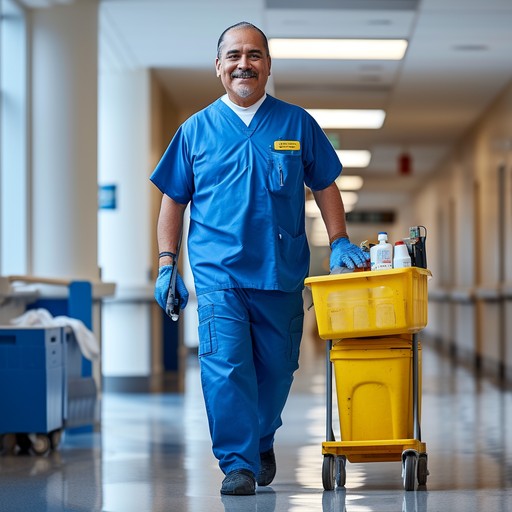Commercial and industrial cleaning in the healthcare industry
The healthcare industry is well known for its high standards of cleanliness and disinfection. One of the hallmarks is the ‘hospital smell’ we all associate with healthcare premises, which highlight the effort that goes into making sure an area is clean and safe.
The use of chemicals has been a long-standing practice in combating hospital or healthcare-associated infections (HAIs). But not just any chemicals will do. They need to be cost-effective but also broad-spectrum, fast-acting, stay wet for the required dwell time and are safe and easy to use.
With COVID-19, the desire and need for areas to be clean and safe – especially among healthcare providers – has only increased. More of us are now conscious about personal hygiene practices like washing hands, using hand sanitisers and wearing masks, but are also more wary of areas frequented by others – especially healthcare facilities.
Outbreaks like COVID-19 often prompt healthcare facilities to take a long, hard look at their cleaning products and protocols to ensure that they’re able to address all threats and keep staff and patients safe against infection.
This is why choosing the right cleaning products is key. Here is some helpful information on the types of cleaning products and chemicals suggested for use and how to apply them.
For cleaning
For cleaning surfaces or equipment, liquid soaps, enzymatic cleaners or detergents are recommended. These are used to remove organic material and suspend grease or oil. To use them effectively, mix them with water and then scrub the surface to clean it.
Ideally, these products are non-toxic, easy to use, have an acceptable odour, are soluble and economical. Increasingly, we’re also seeing a call for environmentally-friendly products that are biodegradable and cause less harm to the environment.
For disinfecting
Disinfecting surfaces or equipment is always done after cleaning unless the product is a combined detergent and disinfectant. There are two levels of disinfectant that are recommended for environmental cleaning: low and intermediate.
Low-level disinfectants, which act as bactericides, virucides and fungicides are often quaternary ammonium compounds such as:
- alkyl dimethyl benzyl ammonium chloride
- alkyl dimethyl ethyl benzyl ammonium chloride.
Intermediate-level disinfectants
These are mainly 60-80% proof alcohols such as:
- Isopropyl alcohol
- ethyl alcohol
- methylated spirits.
These intermediate-level disinfectants are also bactericides, virucides and fungicides.
Intermediate level disinfectants are also available as chlorine releasing agents like:
- bleach
- sodium or calcium hypochlorite
- sodium dichloroisocyanurate and improved hydrogen peroxides like 5% enhanced action formulation hydrogen peroxide and 3% hydrogen peroxide.
These are all bactericidal, virucidal and fungicidal as well as mycobactericidal and sporicidal.
Choosing the right products
Deciding on which product to use can be tricky. With many products and solutions available on the market, it’s important to choose those that will best meet your needs without using more products than required.
The U.S. Centers for Disease Control and Prevention (CDC) advises minimising how many cleaning products you use and noting this in your cleaning policy. Limiting the number of cleaning and disinfectant products will not only make cleaning and staff training easier, but it also reduces the potential for mistakes in preparation and use.
When choosing cleaning products here’s a few things to keep in mind:
- The microbes the product should be targeting
- The surface type it will be used on
- The compatibility of the product with surfaces and materials
- Cost and ease of use
- Safety of the product – both to staff and the environment.
If you know what type of cleaning products you’re after, including which microorganisms you want to neutralise, talking to a commercial and industrial cleaning product specialist like ChemMate is a good idea. They’ll have knowledge and expertise about which products available on the market will meet your needs and your budget.
Best practice guidelines on cleaning
How you use each cleaner and disinfectant at your healthcare facility will depend on each product’s instructions. However, there are some general good practice guidelines you can follow.
- Check the dilution requirements of the product. Too diluted, or not diluted enough, and the product won’t work as intended.
- For disinfectants, make sure you follow dwell time guidelines. For the product to be effective, it needs to stay wet and remain on the surface long enough to kill its targeted microorganisms.
- Use the right equipment and PPE where required to protect the user and ensure the efficacy of the cleaning or disinfectant product.
- Store and prepare the cleaning or disinfectant products in a designated area set aside for this purpose.
Whatever products you choose to clean your health care facility with, it’s reassuring to know you have a reliable commercial and industrial cleaning supplier that can provide high-quality products at competitive prices. To learn more about how ChemMate can support your facility, get in touch.

